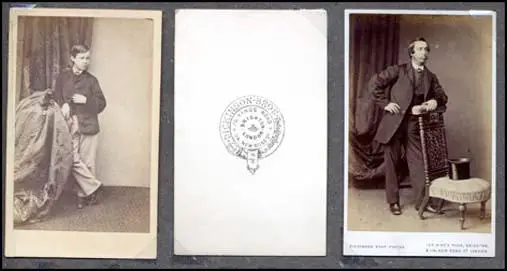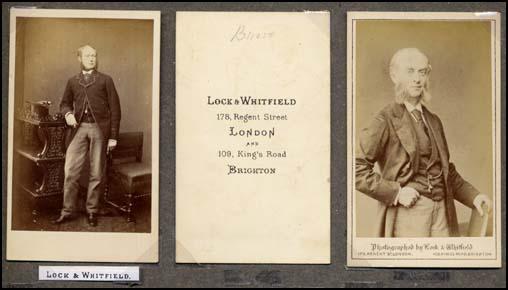High Street Photographers from London
The
1860s saw the arrival of large London firms intent on establishing
branch studios in Brighton.
Dickinson Brothers was a leading firm of printers and publishers
based at 114 New Bond Street. The company had achieved national
recognition for a set of 55 large, coloured lithographs, entitled
'Comprehensive Pictures of the Great Exhibition of 1851',
which illustrated the various display areas at the Crystal Palace.
By 1855, Dickinson Brothers had become interested in photography
and had established two photographic portrait studios in London,
one at their premises in New Bond Street and the other at 174
Regent Street. Dickinson Brothers established a branch studio
at the prime site of 70-71 Kings Road, Brighton around 1862. Lowes
and Gilbert Dickinson carried on their photographic portrait business
in Brighton until 1868, when the demand for carte de visite portraits
had begun to decline.

Around
1862 the London firm of Dickinson Brothers established a photographic
studio at 70 Kings Road, Brighton. By 1867, Dickinson Brothers
had moved their photographic portrait studio to 107 Kings Road,
Brighton, next door to Hennah & Kent at No 108, and Lock &
Whitfield at 109 Kings Road.
1864 saw the arrival of two companies which had already established
a reputation for high class portrait photography in London's fashionable
Regent Street - J J E Mayall and Lock & Whitfield.
Lancashire born John Jabez Edwin Mayall (1813-1901) the
son of a manufacturing Chemist and Dye Works proprietor, had begun
his working life near Huddersfield, West Yorkshire, but around
1842, he travelled to America to study the art and science of
photography under the tutelage of two scientists attached to the
University of Pennsylvania. In 1844, Mayall entered into partnership
with Samuel Van Loan and together they operated a daguerreotype
portrait studio in Philadelphia. A few years later, Mayall returned
to England and by April 1847 he had established a Daguerreotype
Institution at 433, West Strand, London. By 1852, Mayall had opened
a second studio at 224 Regent Street in the West End of London.
Mayall had secured the patronage of Queen Victoria and the Royal
Family and between 1860 and 1862, he published sets of royal portraits
in the carte de visite format, which triggered a craze for collecting
cdv portraits. Mayall achieved fame and fortune. In the year 1861,
he reportedly made £12,000 from his carte de visite portraits.
Leaving
his eldest son Edwin to run his London studios, John J.E.Mayall
moved down to Brighton with his wife and two younger sons
and on 18th July 1864, he opened his new photographic portrait
studio at 90-91 Kings Road, close to the recently built Grand
Hotel. In an announcement placed in the pages of the Brighton
Examiner, Mayall declared that he had "spared neither pains
nor expertise in preparing, for the accommodation of the nobility
and gentry resident at or visiting Brighton, one of the most efficient
studios ever built." Although he addressed his comments particularly
to the "nobililty and gentry", Mayall admitted that
he was "not unmindful of the fact . . . that moderate charges
are as necessary as general excellence to ensure extensive public
patronage." Mayall charged £1.1s (£1.05p) for
a set of 12 carte de visite portraits and £5.5s (£5.25p)
for his "highly finished" coloured portrait photographs.
More modest establishments in Brighton were offering a dozen carte
de visite portraits for 5 shillings (25 p.) in 1864.
Mayall made the guarantee that his new Brighton studio would be
"as successful in operation as it is complete in design".
Mayall's name remained on the Kings Road Studio until 1908, seven
years after his death. Mayall, who lived in the Brighton area
until he died in Southwick on 6th March 1901, involved himself
fully in the life of the town and became active in local politics
and in 1877 he was made Mayor of Brighton.
Lock
& Whitfield, Photographers and Miniature Painters of 178
Regent Street, London established a branch studio at 109 Kings
Road, Brighton in 1864, a few months after Mayall opened his studio
on the same fashionable highway.
Samuel Robert Lock (1822-1881) was an artist who in the
early 1850s was converting talbotype portraits into painted miniatures.
In September 1856, he joined forces with George C.Whitfield
(born c.1833) who had recently built a photographic portrait
studio in London's Regent Street.
In an advertisement placed in a Brighton newspaper, dated 20th
September 1864, Lock & Whitfield offered to take "carte
de visite and every description of photograph, colored or uncolored
(sic), on paper, ivory or porcelain."
Lock & Whitfield was in direct competition with the
other firms from London, Mayall and the Dickinson Brothers, which
also had their studios on Brighton's Kings Road. By 1867, Lock
& Whitfield had fixed the price of twenty carte de visite
portraits at £1.1s.6d (roughly £1.06p.)
Lock & Whitfield probably employed a manager to run their
Brighton studio in the 1860s, but by the time of the 1871 Census,
George C Whitfield was living at Upper Rock Gardens, Brighton
with his wife and five children. Samuel Lock took up residence
in Brighton in 1877, but died 4 years later on 9th May 1881. Lock
& Whitfield's Brighton studio at 109 Kings Road was taken
over by another chain of photographers, Debenham & Co
in 1886.

Carte
de visite portraits taken in Brighton by the London firm of Lock
& Whitfield. After they established a studio in Brighton at
109 Kings Road in 1864, the partners continued to operate a portrait
studio in London at 178 Regent Street.The studio in Regent Street
carried the name of Lock & Whitfield until around 1895.
CLICK HERE TO CONTINUE
The
Cabinet Format